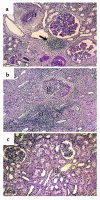Tolerance to solid organ transplants through transfer of MHC class II genes
- PMID: 11134181
- PMCID: PMC198548
- DOI: 10.1172/JCI11015
Tolerance to solid organ transplants through transfer of MHC class II genes
Abstract
Donor/recipient MHC class II matching permits survival of experimental allografts without permanent immunosuppression, but is not clinically applicable due to the extensive polymorphism of this locus. As an alternative, we have tested a gene therapy approach in a preclinical animal model to determine whether expression of allogeneic class II transgenes (Tg's) in recipient bone marrow cells would allow survival of subsequent Tg-matched renal allografts. Somatic matching between donor kidney class II and the recipient Tg's, in combination with a short treatment of cyclosporine A, prolonged graft survival with DR and promoted tolerance with DQ. Class II Tg expression in the lymphoid lineage and the graft itself were sequentially implicated in this tolerance induction. These results demonstrate the potential of MHC class II gene transfer to permit tolerance to solid organ allografts.
Figures




Comment in
-
The tolerant recipient: looking great in someone else's genes.J Clin Invest. 2001 Jan;107(1):33-4. doi: 10.1172/JCI11969. J Clin Invest. 2001. PMID: 11134177 Free PMC article. Review. No abstract available.
Similar articles
-
Successful induction of long-term specific tolerance to fully allogeneic renal allografts in miniature swine.Transplantation. 1992 Feb;53(2):438-44. doi: 10.1097/00007890-199202010-00033. Transplantation. 1992. PMID: 1531395
-
Development of tolerance to class II-mismatched renal transplants after a short course of cyclosporine therapy in miniature swine.Transplantation. 1994 May 15;57(9):1303-8. doi: 10.1097/00007890-199405150-00002. Transplantation. 1994. PMID: 8184465
-
Induction of tolerance to renal allografts across single-haplotype MHC disparities in miniature swine.Transplantation. 1995 Mar 27;59(6):884-90. Transplantation. 1995. PMID: 7701585
-
The tolerant recipient: looking great in someone else's genes.J Clin Invest. 2001 Jan;107(1):33-4. doi: 10.1172/JCI11969. J Clin Invest. 2001. PMID: 11134177 Free PMC article. Review. No abstract available.
-
Effect of major histocompatibility complex matching on the development of tolerance to primarily vascularized renal allografts: a study in miniature swine.Hum Immunol. 1996 Sep 15;50(1):1-10. doi: 10.1016/0198-8859(96)00059-6. Hum Immunol. 1996. PMID: 8872170 Review.
Cited by
-
Use of a 3D Floating Sphere Culture System to Maintain the Neural Crest-Related Properties of Human Dental Pulp Stem Cells.Front Physiol. 2018 May 28;9:547. doi: 10.3389/fphys.2018.00547. eCollection 2018. Front Physiol. 2018. PMID: 29892229 Free PMC article.
-
Manipulating IL-2 availability amid presentation of donor MHC antigens suppresses murine alloimmune responses by inducing regulatory T cells.PLoS One. 2010 Jan 18;5(1):e8756. doi: 10.1371/journal.pone.0008756. PLoS One. 2010. PMID: 20090908 Free PMC article.
-
Intracellular MHC class II controls regulatory tolerance to allogeneic transplants.J Immunol. 2010 Mar 1;184(5):2394-400. doi: 10.4049/jimmunol.0803664. Epub 2010 Jan 25. J Immunol. 2010. PMID: 20100928 Free PMC article.
-
Tolerization of a type I allergic immune response through transplantation of genetically modified hematopoietic stem cells.J Immunol. 2008 Jun 15;180(12):8168-75. doi: 10.4049/jimmunol.180.12.8168. J Immunol. 2008. PMID: 18523282 Free PMC article.
-
Donor Lymphocyte Infusion-Mediated Graft-versus-Host Responses in a Preclinical Swine Model of Haploidentical Hematopoietic Cell Transplantation.Biol Blood Marrow Transplant. 2016 Nov;22(11):1953-1960. doi: 10.1016/j.bbmt.2016.08.011. Epub 2016 Aug 16. Biol Blood Marrow Transplant. 2016. PMID: 27543159 Free PMC article.
References
-
- Vanrenterghem YF. Impact of new immunosuppressive agents on late graft outcome. Kidney Int Suppl. 1997;63:S81–S83. - PubMed
-
- Shaw LM, Kaplan B, Kaufman D. Toxic effects of immunosuppressive drugs: mechanisms and strategies for controlling them. Clin Chem. 1996;42:1316–1321. - PubMed
-
- Rosengard BR, et al. Induction of specific tolerance to class I disparate renal allografts in miniature swine with cyclosporine. Transplantation. 1992;54:490–497. - PubMed
-
- Nojima M, et al. The significant effect of HLA-DRB1 matching on acute rejection in kidney transplants. Transpl Int. 1996;9(Suppl. 1):S11–S15. - PubMed
-
- Emery DW, et al. Expression of an allogeneic MHC DRB transgene, through retroviral transduction of bone marrow, induces specific reduction of alloreactivity. Transplantation. 1997;64:1414–1423. - PubMed
Publication types
MeSH terms
Substances
Grants and funding
LinkOut - more resources
Full Text Sources
Other Literature Sources
Research Materials
Miscellaneous

